Streamline Your Payment Collection with 23 Expertly Crafted Follow-up Letter Templates
Welcome to our comprehensive resource on payment follow-up letters! We understand the challenges businesses face when it comes to timely payment collection and maintaining healthy cash flow. That’s why we have curated a collection of professionally crafted payment follow-up letters to help you navigate through the process with ease and effectiveness. Whether you need to send a polite reminder, address a payment discrepancy, propose a payment plan, or handle more assertive situations, our diverse range of letter templates is designed to cater to your specific needs. Along with these ready-to-use templates, we provide additional content such as tips, strategies, and a glossary to enhance your understanding of payment follow-up best practices. With our resources at your disposal, you can streamline your payment collection process, improve your customer relationships, and achieve better financial stability. Explore our website page and empower your business with effective payment follow-up solutions.
Benefits of Payment Follow-up
Implementing a systematic approach to payment follow-up offers several key benefits for businesses. Here are some advantages to highlight on your website’s “Payment Follow-up Letters” page:
- Improved Cash Flow: Promptly following up on outstanding payments helps accelerate the collection process, leading to improved cash flow. By reminding customers about their payment obligations, businesses can ensure that funds are received in a timely manner, reducing the need for prolonged credit terms and boosting working capital.
- Reduced Outstanding Balances: Consistent payment follow-up efforts can effectively reduce outstanding balances owed by customers. By staying on top of overdue payments and actively engaging with customers, businesses can encourage them to settle their debts promptly, minimizing the risk of bad debts or write-offs.
- Stronger Customer Relationships: Regular payment follow-up demonstrates your commitment to maintaining a positive business relationship with your customers. By addressing payment matters promptly, professionally, and respectfully, you can reinforce trust, reliability, and customer loyalty. Effective communication during the follow-up process can also uncover any potential issues or concerns that may be affecting timely payments, allowing for proactive resolution and strengthening the partnership.
- Enhanced Financial Planning: By implementing a systematic payment follow-up process, businesses gain better visibility and control over their cash flow. This improved predictability allows for more accurate financial planning and forecasting, enabling informed decision-making and resource allocation.
- Reduced Administrative Burden: Having a structured approach to payment follow-up can streamline administrative tasks related to tracking and managing overdue payments. Automated reminders and templates can save time and effort, allowing your team to focus on more value-added activities and overall business growth.
- Minimized Disputes and Discrepancies: Proactive payment follow-up can help identify and resolve any payment disputes or discrepancies promptly. By addressing concerns and clarifying any issues in a timely manner, businesses can prevent disputes from escalating and maintain positive customer relationships.
#1: Initial Payment Reminder Letter:
A polite reminder to the customer about an outstanding payment. The initial payment reminder letter serves as polite and friendly communication to remind the customer about an outstanding payment. Its purpose is to gently nudge the customer to fulfill their financial obligation while maintaining a professional relationship. This letter is an effective way to ensure timely payment and avoid any potential misunderstandings or delays. It communicates the importance of prompt payment without being overly assertive, allowing the customer to address the matter promptly and maintain a positive rapport with the company.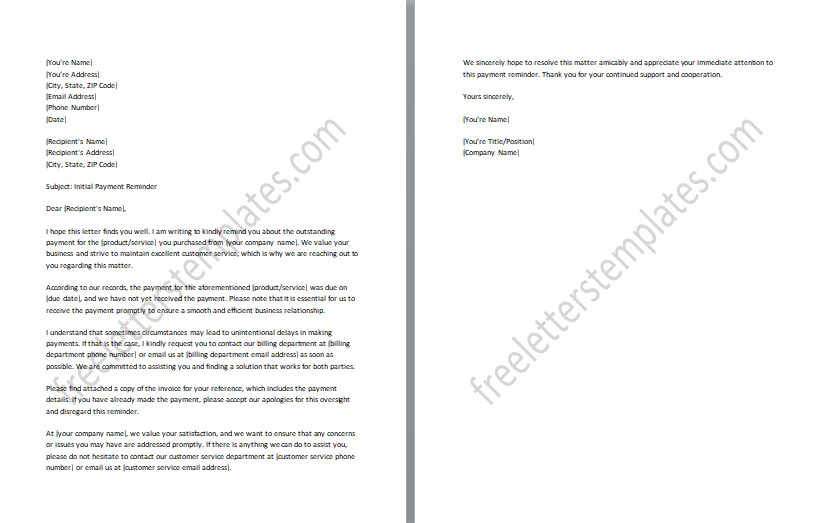
#2: Second Payment Reminder Letter:
A follow-up letter was sent after the initial reminder to prompt payment. The second payment reminder letter is a follow-up communication sent after the initial reminder to prompt payment from the customer. Its purpose is to remind the customer once again about the outstanding payment, indicating that the payment due date has passed or is approaching. This letter serves as a more assertive reminder, emphasizing the importance of settling the payment promptly. It aims to convey a sense of urgency while maintaining a professional tone encouraging the customer to take immediate action and submit the payment to avoid any potential consequences or further follow-up actions.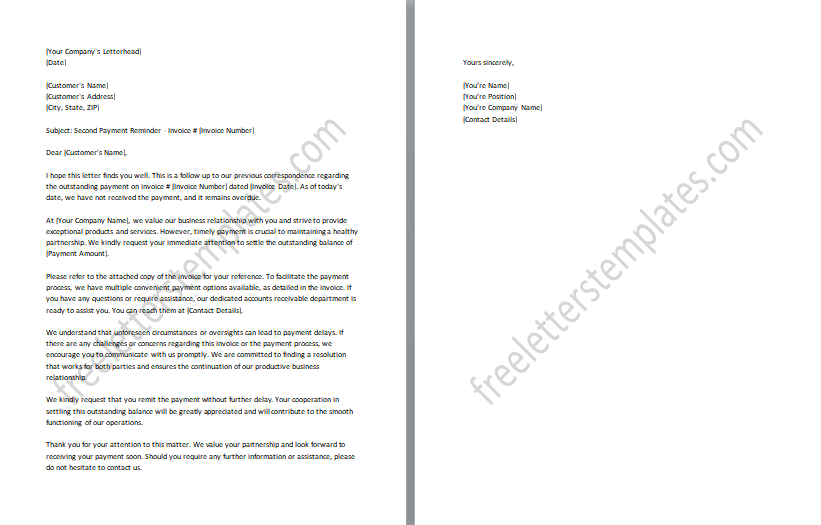
#3: Final Payment Reminder Letter:
A more assertive letter was sent as a last attempt to collect payment before taking further action. The final payment reminder letter is a more assertive communication sent as a last attempt to collect payment from the customer before taking further action. Its purpose is to convey a sense of urgency and clearly communicate that the payment is overdue. This letter serves as a final reminder before escalating the matter, such as involving a collections agency or taking legal action. It may emphasize the potential consequences of non-payment, such as late fees, credit damage, or legal proceedings. While maintaining a professional tone, this letter aims to motivate the customer to settle the outstanding payment immediately to avoid any further actions that may have negative repercussions on their credit history or business relationship with the company.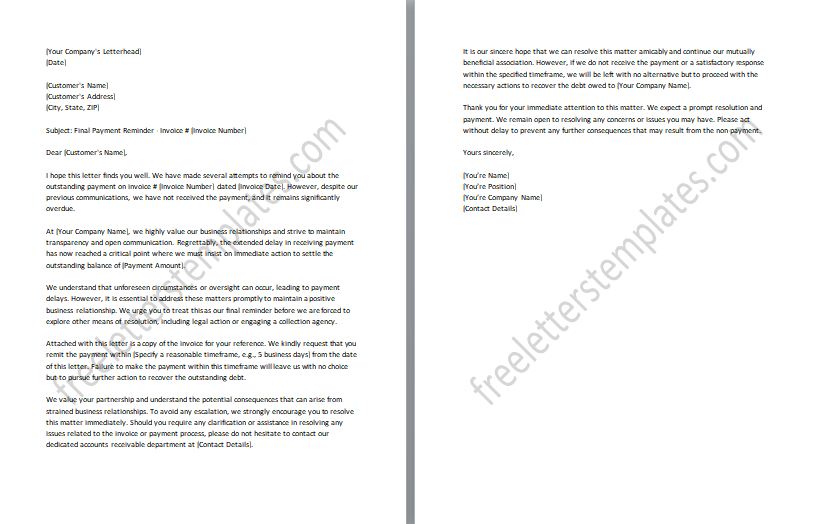
#4: Overdue Payment Notice:
A letter notifying the customer that their payment is past due and immediate action is required. An overdue payment notice is a letter sent to notify the customer that their payment is past due and immediate action is required. The purpose of this letter is to clearly communicate that the payment is overdue and emphasize the urgency of resolving the outstanding balance. It serves as a formal reminder, stating the specific amount and the date on which the payment was due. The notice may also include any applicable late fees or consequences for non-payment. While maintaining a professional tone, this letter is intended to prompt the customer to take immediate action and submit the payment to avoid any further escalation or potential negative impact on their credit history or business relationship with the company.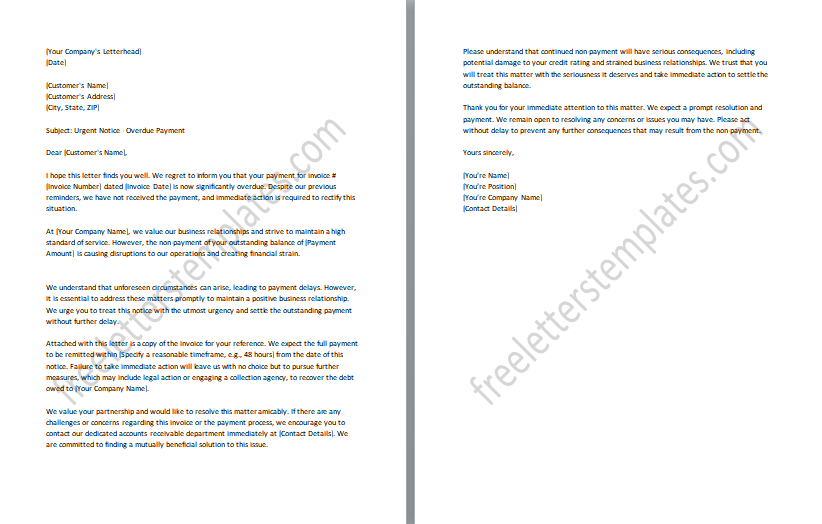
#5: Late Payment Fee Letter:
A letter informing the customer about the additional charges or fees due to late payment. A late payment fee letter is a communication sent to inform the customer about the additional charges or fees incurred due to their late payment. The letter may also serve as a gentle reminder to settle the outstanding payment promptly to avoid any further accumulation of fees or consequences. While maintaining a professional tone, this letter emphasizes the importance of timely payment and encourages the customer to fulfill their financial obligation while also addressing any concerns or inquiries they may have regarding the fee.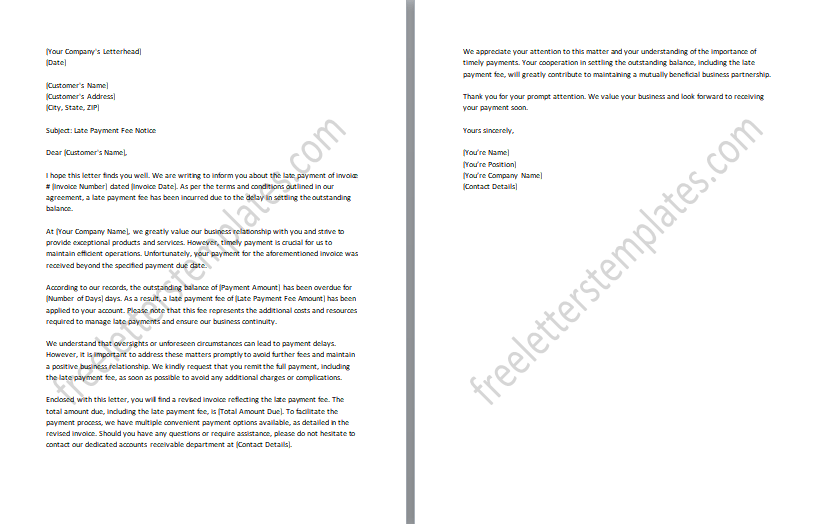
#6: Payment Arrangement Proposal Letter:
A letter proposing a payment plan or installment options to assist the customer in settling their dues. A payment arrangement proposal letter is a communication sent to the customer, outlining a proposed payment plan or installment options to assist them in settling their outstanding dues. The letter highlights the company’s willingness to work with the customer and find a mutually beneficial arrangement that allows them to fulfill their financial obligation over a specified period. It outlines the proposed terms, including the amount, frequency, and duration of the installments, while also considering the customer’s financial capacity. This letter aims to maintain a positive relationship with the customer, demonstrating flexibility and understanding, while also ensuring that the outstanding balance is gradually paid off in a structured manner.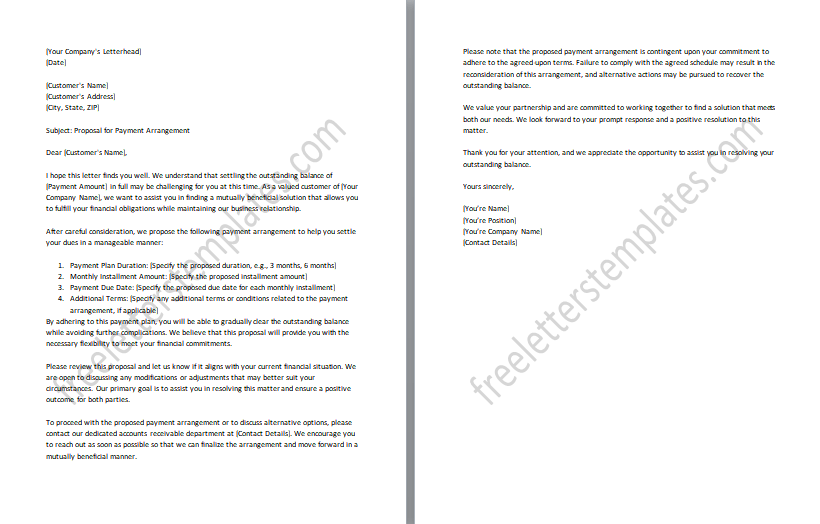
#7: Payment Confirmation Request Letter:
A letter requesting confirmation from the customer regarding their payment to ensure accuracy. A payment confirmation request letter is a communication sent to the customer, requesting confirmation regarding their payment to ensure accuracy. The purpose of this letter is to seek verification from the customer that their payment has been received and accurately recorded by the company. The letter acknowledges the customer’s payment and expresses gratitude for their timely action while emphasizing the importance of maintaining accurate financial records. This letter aims to foster transparency and open communication with the customer, ensuring that both parties are aligned in terms of the payment transaction details. It provides an opportunity for the customer to address any discrepancies or provide additional information, if necessary, to facilitate a seamless reconciliation process.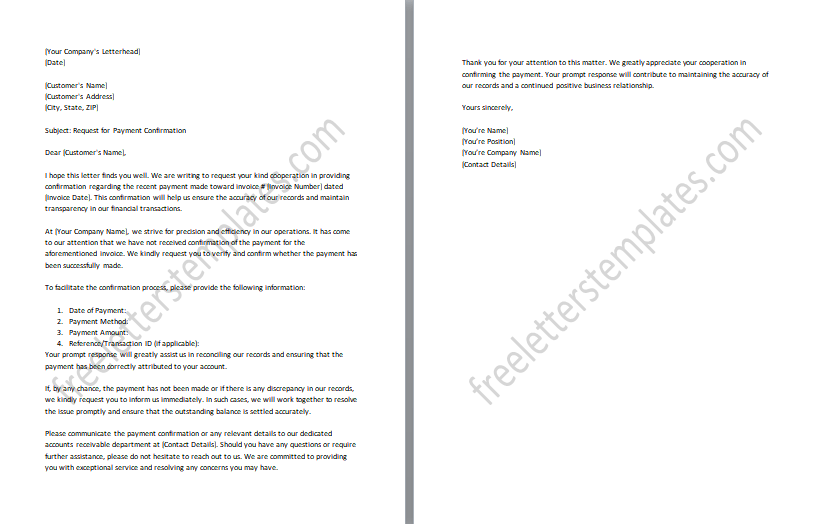
#8: Payment Acknowledgment Letter:
A letter expressing gratitude for the customer’s timely payment. The payment acknowledgment letter is a communication sent to express gratitude to the customer for their timely payment. Its purpose is to acknowledge the receipt of the payment and convey appreciation for the customer’s promptness in fulfilling their financial obligation. This letter serves to strengthen the business relationship by recognizing the customer’s commitment and prompt action. It may also reiterate the importance of their payment in supporting the company’s operations. While maintaining a professional tone, this letter aims to convey a sense of gratitude and satisfaction, reinforcing the positive business rapport with the customer.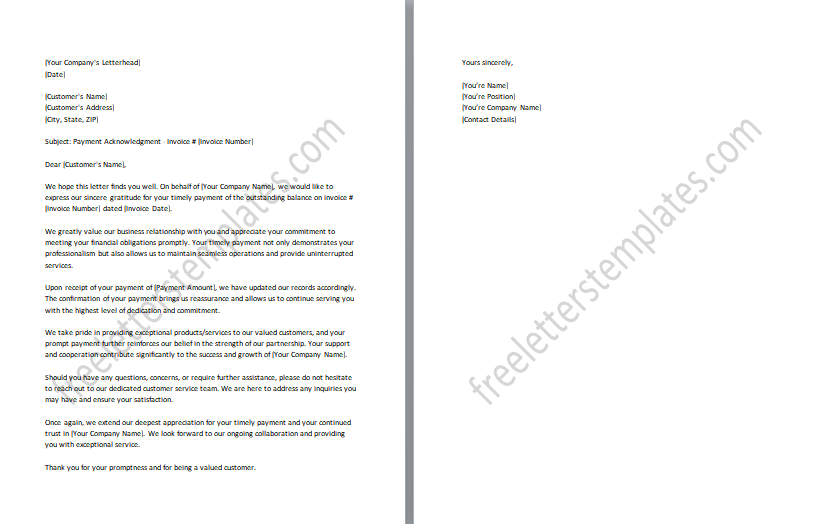
#9: Payment Reversal Letter:
A letter informing the customer about the payment reversal due to an error or issue. The payment reversal letter is a communication sent to notify the customer about the reversal of payment due to an error or issue. Its purpose is to inform the customer of the situation and provide an explanation for the reversal. This letter aims to maintain transparency and clarity in financial transactions, ensuring that both parties are aware of any adjustments made to their accounts. It may also outline any necessary steps for the customer to take, such as resubmitting the payment or contacting customer support for further assistance. While maintaining a professional tone, this letter aims to address the situation promptly and minimize any inconvenience caused to the customer.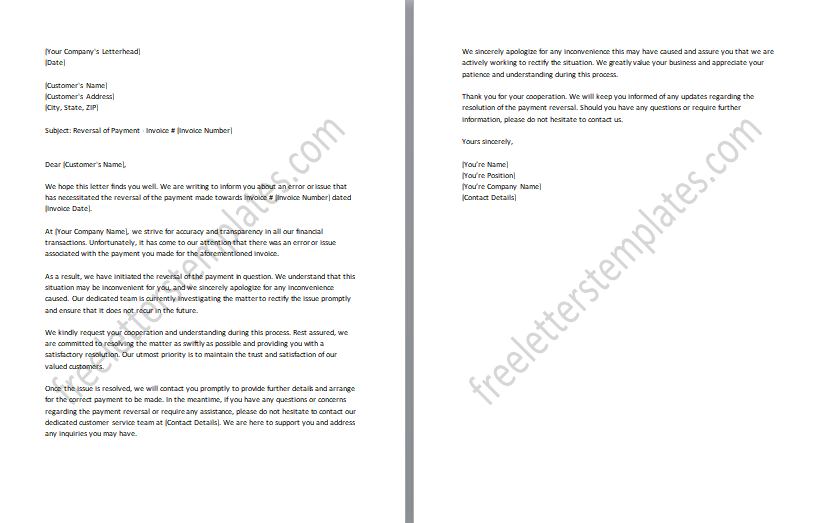
#10: Payment Discrepancy Inquiry Letter:
A letter seeking clarification from the customer regarding a discrepancy in the payment amount or details. The payment discrepancy inquiry letter is a communication sent to the customer seeking clarification regarding a discrepancy in the payment amount or details. Its purpose is to address any inconsistencies or discrepancies identified in the payment received and to seek the customer’s input or explanation. This letter aims to maintain open and transparent communication with the customer, ensuring that any errors or misunderstandings are promptly resolved. It may include specific details about the discrepancy, such as the payment amount, invoice number, and date while requesting the customer’s assistance in clarifying the situation.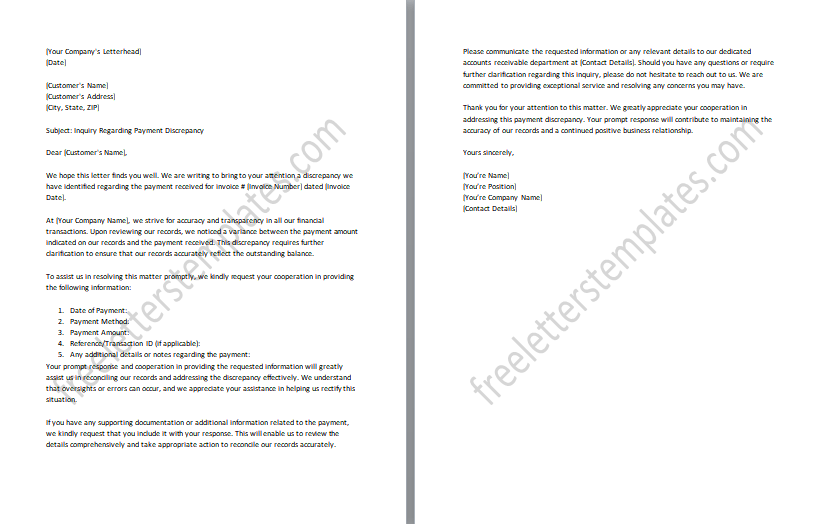
#11: Payment Extension Request Letter:
A letter requesting an extension on the payment due date. The payment extension request letter is a communication sent to the customer, seeking an extension on the payment due date. Its purpose is to explain the need for additional time to settle the outstanding balance and to request the customer’s understanding and cooperation in granting the extension. This letter aims to maintain open communication and foster a positive relationship with the customer while addressing temporary financial constraints or unexpected situations. It outlines the specific reasons for the request and may include any relevant supporting documentation. By maintaining a professional tone and expressing appreciation for their consideration, this letter seeks to arrive at a mutually beneficial agreement that allows the customer to fulfill their financial obligation within an extended timeframe.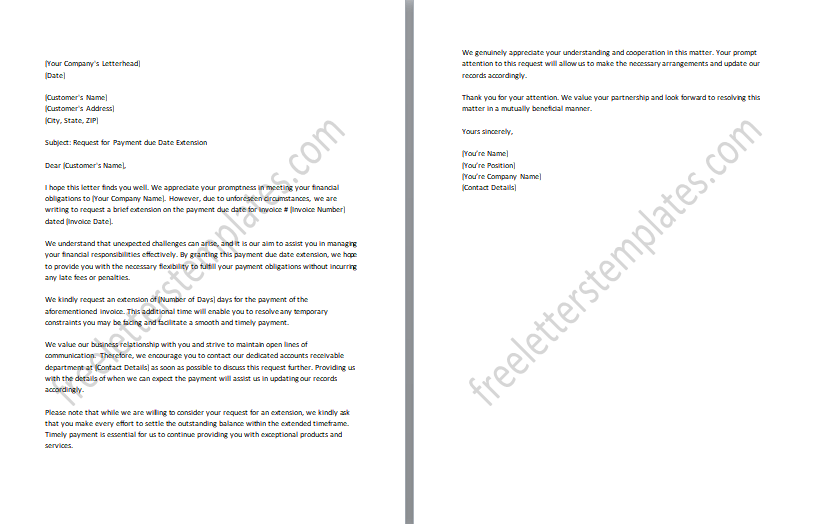
#12: Payment Settlement Offer Letter:
A letter proposes a settlement or discount on the outstanding payment amount. The payment settlement offer letter is a communication sent to the customer, proposing a settlement or discount on the outstanding payment amount. Its purpose is to present a mutually beneficial resolution for both parties involved, offering a reduced payment amount or alternative payment terms to settle the outstanding balance. This letter aims to address any financial challenges or difficulties faced by the customer while also ensuring that the company receives a reasonable portion of the payment. It outlines the proposed settlement terms, including the discounted amount or revised payment schedule, and may include any conditions or requirements for accepting the offer. While maintaining a professional tone, this letter aims to initiate a constructive dialogue and reach a mutually agreeable resolution that satisfies both the customer and the company.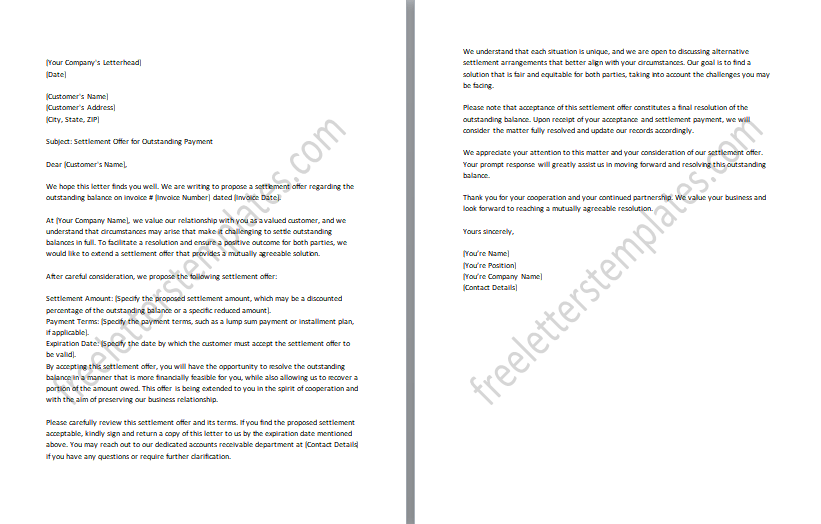
#13: Invoice Dispute Resolution Letter:
A letter addressing a dispute or discrepancy in the invoice and requesting prompt payment. The invoice dispute resolution letter is a communication sent to address a dispute or discrepancy in the invoice and request prompt payment. Its purpose is to acknowledge the customer’s concerns or objections regarding the invoice and initiate a resolution process. This letter aims to maintain transparency and open communication while ensuring that the outstanding payment is addressed promptly. It may outline the specific details of the dispute, provide explanations or clarifications, and propose a resolution to rectify the issue. The letter also emphasizes the importance of timely payment and may include a gentle reminder of the payment due date. While maintaining a professional and understanding tone, this letter seeks to find a satisfactory resolution that satisfies both parties and allows for the prompt settlement of the invoice.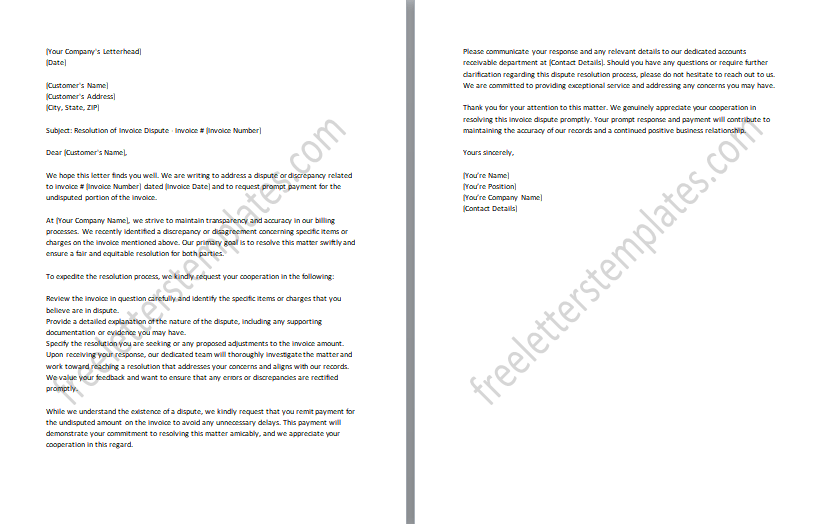
#14: Legal Action Warning Letter:
A letter warning the customer about potential legal action if payment is not made promptly. The legal action warning letter is a communication sent to warn the customer about the potential consequences of non-payment and the initiation of legal action if the payment is not made promptly. Its purpose is to clearly communicate the seriousness of the situation and the potential legal repercussions involved. This letter aims to emphasize the urgency of settling the outstanding payment and highlights the steps that may be taken if the payment is not received within a specified timeframe. It may outline the specific actions that will be pursued, such as involving a collections agency, filing a lawsuit, or seeking justice in a court of law. While maintaining a professional tone, this letter serves as a final notice, urging the customer to fulfill their financial obligation and avoid any further legal proceedings that may have negative consequences.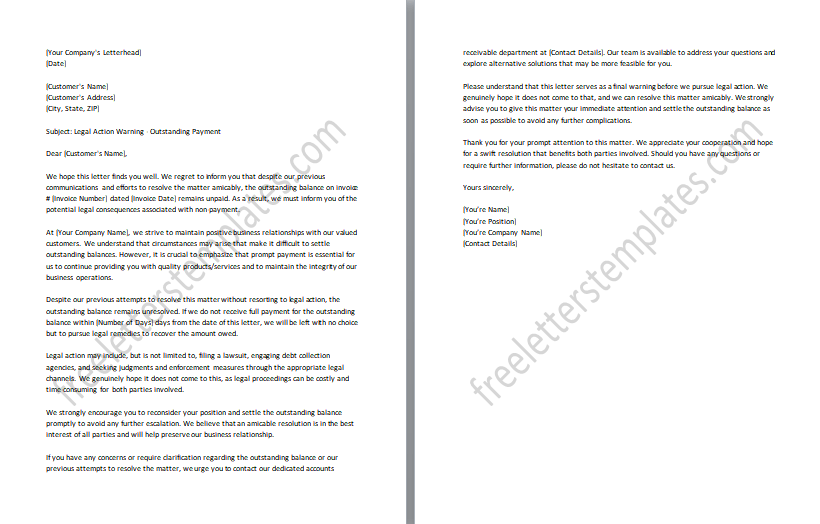
#15: Thank You for the Payment Letter:
A letter expressing appreciation to the customer for making a payment. The thank you for payment letter is a communication sent to express sincere appreciation to the customer for making a payment. Its purpose is to acknowledge the customer’s timely action in settling their financial obligation and to convey gratitude for their cooperation. This letter aims to strengthen the business relationship, highlighting the customer’s contribution to the company’s success. It may also include a brief statement about how the payment positively impacts the company’s operations or supports ongoing projects. While maintaining a professional tone, this letter seeks to foster goodwill and maintain a positive rapport with the customer, encouraging continued collaboration and a mutually beneficial business relationship.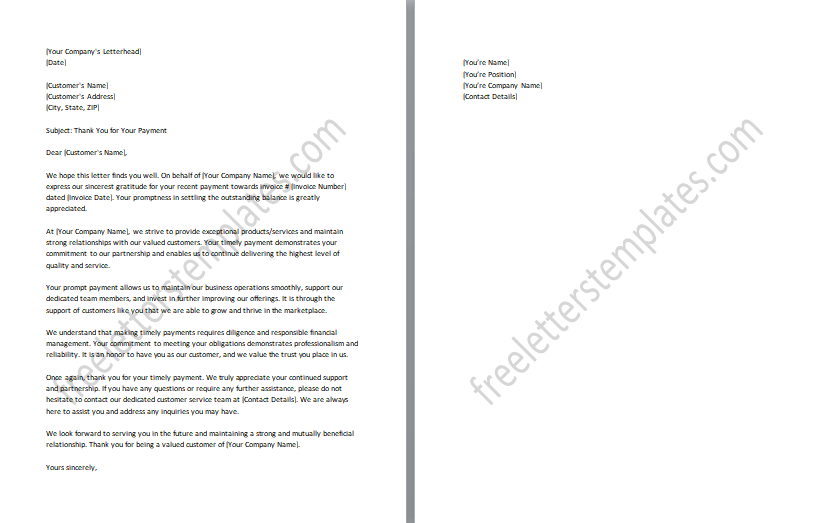
#16: Payment Follow-up after Disputed Charges:
A letter is sent after resolving a payment dispute, reminding the customer to settle the remaining balance. The payment follow-up letter after resolving a payment dispute is a communication sent to the customer as a reminder to settle the remaining balance after the dispute has been resolved. Its purpose is to bring attention to the outstanding amount that still needs to be paid despite the previous dispute resolution. This letter aims to maintain clear communication and ensure that all financial obligations are fulfilled. It may briefly summarize the resolution of the dispute, express appreciation for the customer’s cooperation in reaching a resolution, and provide clear instructions for settling the remaining balance. While maintaining a professional and courteous tone, this letter serves as a gentle reminder to the customer to complete the payment process and ensure that all outstanding amounts are settled in a timely manner.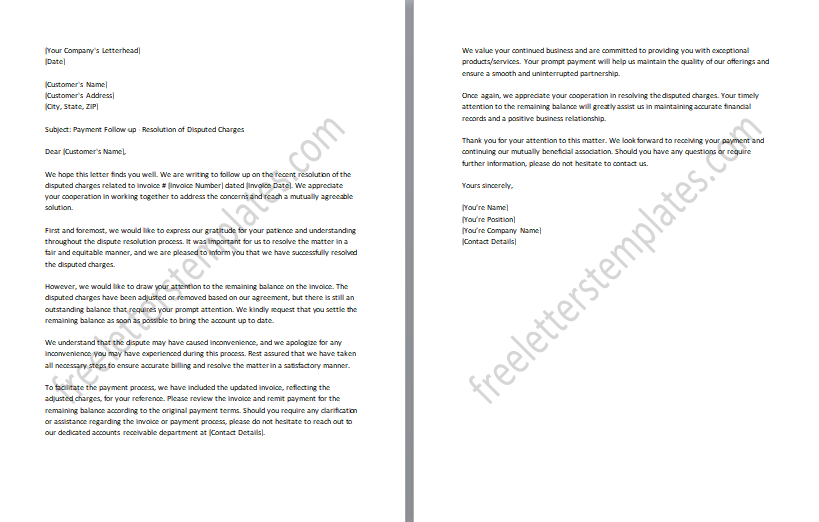
#17: Credit Hold Release Letter:
A letter informing the customer that their credit hold has been released after receiving the payment. The credit hold release letter is a communication sent to the customer, notifying them that their credit hold has been released after the payment is received. Its purpose is to inform the customer that their account is now in good standing and that any restrictions on credit or services have been lifted. This letter aims to convey positive news to the customer, acknowledging their prompt payment and expressing gratitude for their cooperation. It may include details about the payment received, the updated account status, and any relevant instructions for resuming normal business activities. While maintaining a professional tone, this letter seeks to maintain a positive business relationship with the customer and ensure a smooth continuation of services without any further disruptions.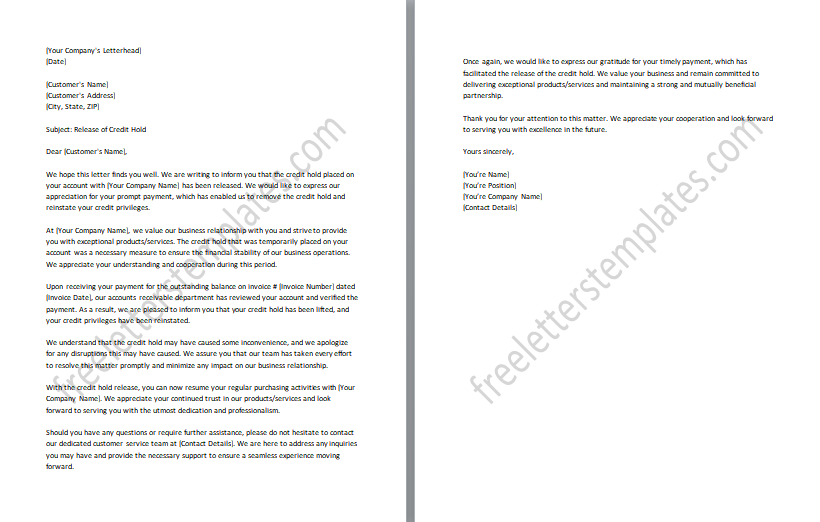
#18: Returned Check Notification Letter:
A letter notifying the customer that their payment by check was returned and requesting an alternative form of payment. The returned check notification letter is a communication sent to the customer, informing them that their payment by check has been returned and requesting an alternative form of payment. Its purpose is to notify the customer of the returned check and provide details regarding the reason for the return, such as insufficient funds or a technical issue. This letter aims to address the issue promptly and facilitate the collection of the outstanding payment. It may include instructions on how to submit a new payment, such as through electronic transfer, credit card, or certified funds, and may also include any associated fees or penalties. While maintaining a professional and courteous tone, this letter seeks to resolve the payment issue in a timely manner and maintain a positive business relationship with the customer.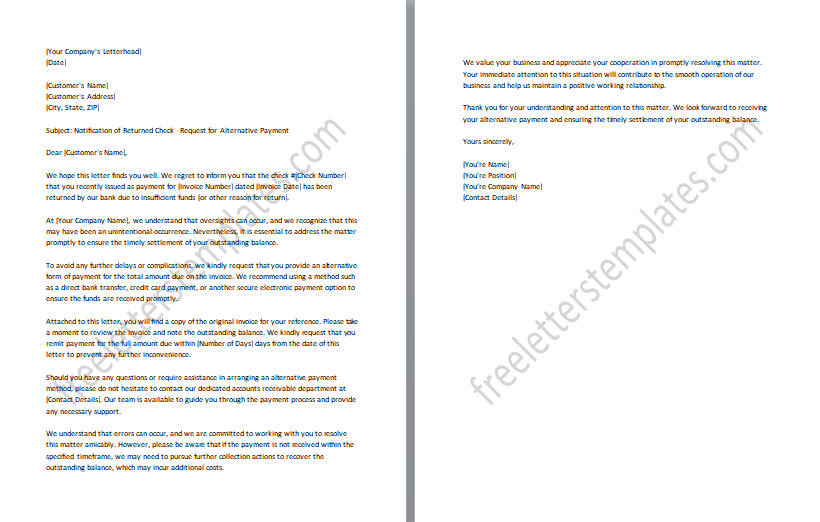
#19: Payment Reminder for Subscription Renewal:
A letter reminding the customer about the upcoming payment for subscription renewal. The payment reminder for subscription renewal letter is a communication sent to the customer, reminding them about the upcoming payment for their subscription renewal. Its purpose is to ensure that the customer is aware of the approaching renewal date and to prompt them to make the necessary payment to continue their subscription. This letter aims to maintain a seamless subscription process, minimize any disruptions in service, and ensure that the customer has ample time to submit the payment before the renewal deadline. It may include details about the subscription, the renewal date, the payment amount, and instructions on how to make the payment. While maintaining a professional tone, this letter serves as a friendly reminder and encourages the customer to take action in order to maintain their subscription benefits without interruption.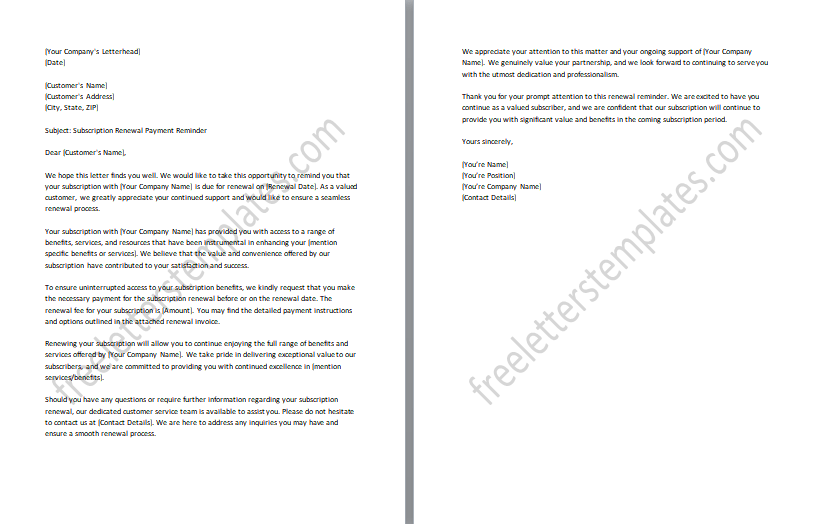
#20: Payment Delay Explanation Letter:
A letter explaining the reasons for a delay in payment and requesting understanding from the recipient. The payment delay explanation letter is a communication sent to explain the reasons for a delay in payment and request understanding from the recipient. Its purpose is to provide a clear and honest explanation for the delay in making the payment and to seek the recipient’s understanding and patience during this time. This letter aims to maintain open and transparent communication, fostering a positive relationship between the parties involved. It may outline the specific circumstances or challenges that led to the delay, such as financial constraints, unforeseen events, or internal processing issues. While maintaining a professional and apologetic tone, this letter emphasizes the commitment to fulfilling the payment obligation and may propose a revised payment timeline or offer alternative solutions if feasible.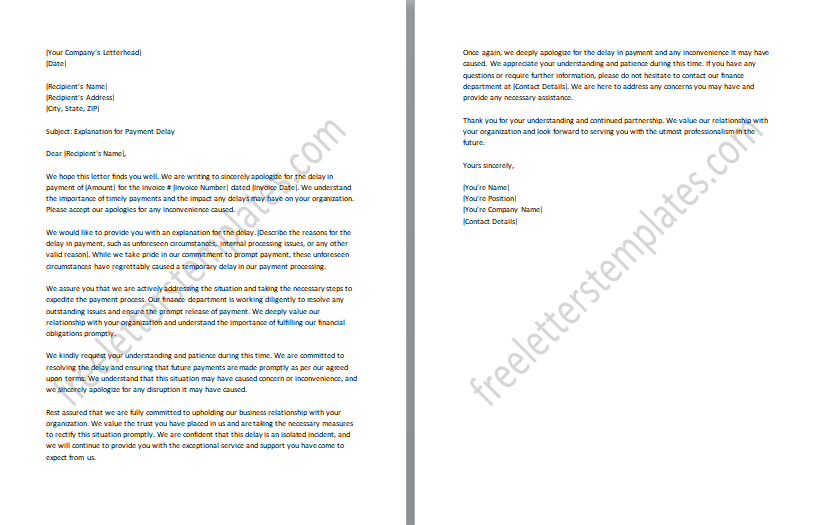
#21: Payment Receipt Request Letter:
A letter requesting a receipt or proof of payment from the customer. The payment receipt request letter is a communication sent to the customer, requesting a receipt or proof of payment. Its purpose is to formally ask the customer to provide documentation that confirms the completion of the payment transaction. This letter aims to ensure accurate record-keeping, facilitate financial reconciliation, and provide documentation for auditing or tax purposes. It may specify the necessary details that should be included in the receipt, such as the payment amount, date, payment method, and invoice number. While maintaining a professional and courteous tone, this letter serves as a formal request for the customer’s cooperation in providing the requested receipt. By obtaining the receipt, the company can maintain accurate financial records and enhance transparency in its business transactions.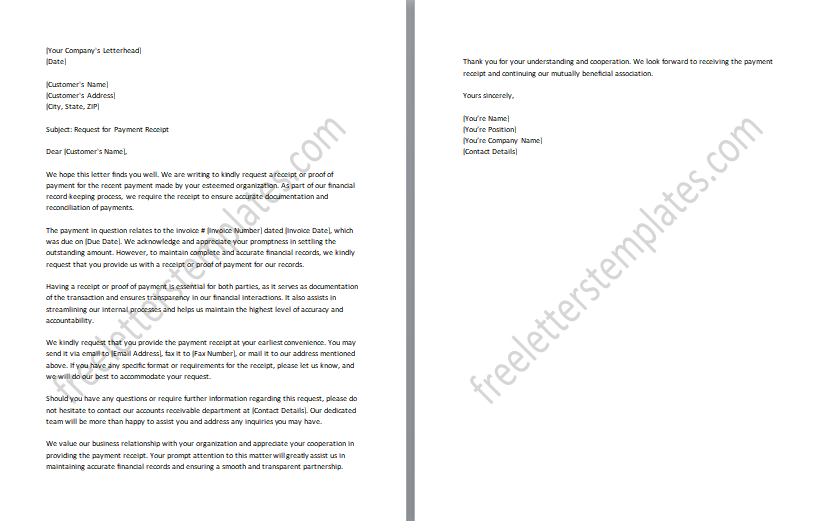
#22: Payment Allocation Update Letter:
A letter informing the customer about allocating their payment to specific invoices or accounts. The payment allocation update letter is a communication sent to the customer, informing them about allocating their payment to specific invoices or accounts. Its purpose is to provide transparency and clarity regarding how their payment has been distributed among their outstanding balances. It may outline the specific invoices or accounts to which the payment has been allocated, along with the corresponding amounts. Additionally, it may provide a summary of any remaining balances or adjustments resulting from the payment allocation. While maintaining a professional tone, this letter serves to keep the customer informed about the status of their payments and fosters transparency in financial transactions between the company and the customer.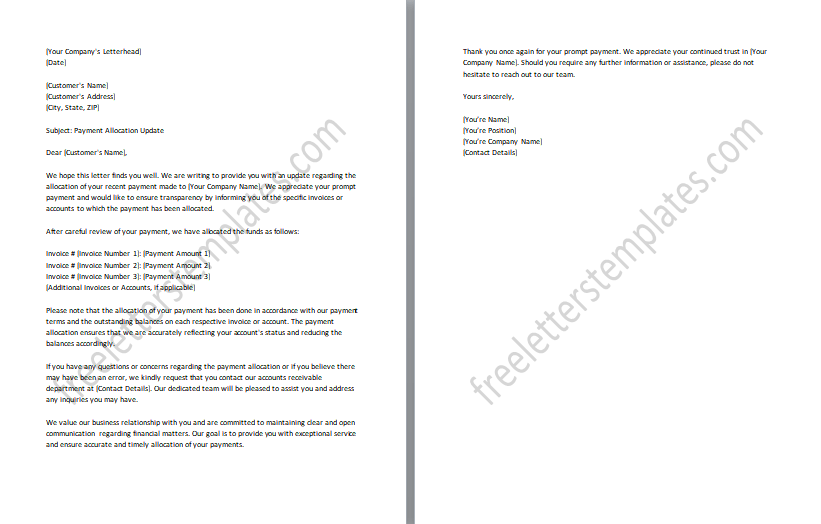
#23: Payment Overpayment Refund Letter:
A letter notifying the customer about an overpayment and requesting their preferred method for issuing a refund. The payment overpayment refund letter is a communication sent to the customer, notifying them about an overpayment and requesting their preferred method for issuing a refund. Its purpose is to inform the customer about the excess payment made and initiate the process of refunding the overpaid amount. This letter aims to maintain transparency and customer satisfaction by promptly addressing the overpayment situation. It may include details about the specific amount overpaid, the original payment, and the refund options available to the customer, such as a refund via check, electronic transfer, or credit toward future purchases. While maintaining a professional and helpful tone, this letter seeks to ensure that the customer’s preferred method of refund is accommodated and that the excess payment is returned in a timely manner.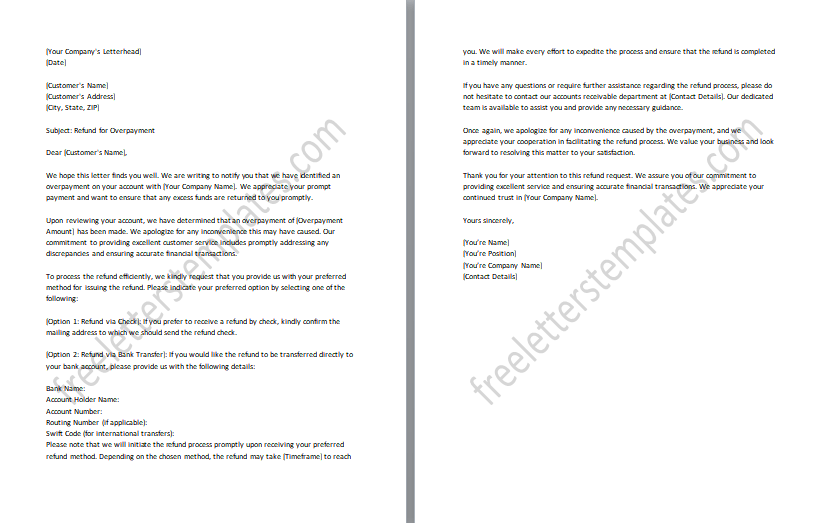
Tips for Writing Effective Payment Follow-up Letters
When writing effective payment follow-up letters, it’s crucial to strike the right balance between professionalism and persuasion. Here are some practical tips and guidelines to consider:
- Use a Respectful Tone: Maintain a professional and courteous tone throughout the letter. Avoid using aggressive or confrontational language, as it may strain the customer relationship. Be firm yet polite in reminding the customer of their outstanding payment.
- Highlight Consequences: Clearly outline the consequences of non-payment or delayed payment. Emphasize the potential impact on the customer’s credit score, additional fees or penalties, and potential disruption of services or business relationships. However, ensure that the tone remains informative rather than threatening.
- Provide Clear Payment Instructions: Clearly state the payment amount, due date, and acceptable payment methods. Include detailed instructions on how the customer can make the payment, such as through online platforms, bank transfers, or by checks. Offer multiple payment options, if available, to facilitate prompt payment.
- Personalize the Letter: Whenever possible, address the customer by name and refer to specific details related to their outstanding payment. This personal touch demonstrates attention to detail and shows the customer that the communication is tailored to their situation.
- Be Concise and Clear: Keep the letter concise and to the point. Clearly communicate the purpose of the letter and the desired outcome. Use simple and jargon-free language to ensure the customer understands the message and the necessary actions.
- Include Relevant Documentation: Attach or reference relevant documentation, such as invoices, statements, or payment history, to support your message and clarify any discrepancies or confusion regarding the outstanding payment.
- Offer Assistance: Express willingness to assist the customer in resolving any issues or concerns they may have regarding the payment. Provide contact information and encourage them to reach out for any questions or assistance they may need.
- Follow-Up Timeline: Set a timeline for the customer to respond or make the payment. Clearly indicate the deadline to create a sense of urgency and to establish clear expectations.
- Proofread and Edit: Before sending the letter, thoroughly proofread and edit it to ensure clarity, accuracy, and professionalism. Typos or grammatical errors can undermine the credibility of the letter and the seriousness of the payment follow-up.
Glossary of Common Terms and Phrases
Here are some common terms and phrases that you can include in your glossary related to payment follow-up:
- Accounts Receivable: The amount of money owed to a business by its customers for goods or services provided on credit.
- Invoices: Documents that itemize the products or services provided, along with the amount owed by the customer.
- Payment Terms: The agreed-upon conditions for payment, including the due date, payment method, and any applicable discounts or late payment penalties.
- Due Diligence: The process of conducting thorough research and investigation to verify the accuracy of payment information and ensure compliance with legal and financial requirements.
- Late Payment: A payment that is not made by the agreed-upon due date, resulting in a delay in settling the outstanding amount.
- Payment Reminder: A communication sent to remind customers of an upcoming or overdue payment, usually in the form of an email, letter, or phone call.
- Collection Agency: A company or organization specialized in collecting overdue payments on behalf of businesses, usually for a fee or percentage of the amount recovered.
- Payment Plan: An agreement between a business and a customer to settle an outstanding balance through a series of scheduled payments over an extended period of time.
- Dunning Letter: A formal letter sent to a customer regarding an overdue payment, typically containing a reminder of the outstanding balance and any applicable late fees or consequences.
- Credit Hold: A temporary suspension of a customer’s credit privileges or the ability to make additional purchases on credit due to non-payment or significant overdue balances.
- Write-off: The act of removing an outstanding balance from a business’s accounts receivable due to the unlikelihood of payment, often as a result of bankruptcy, insolvency, or other financial difficulties faced by the customer.
- Payment Allocation: The process of distributing received payments to specific invoices or accounts, ensuring that each payment is appropriately applied to the corresponding outstanding balances.
- Dispute Resolution: The process of addressing and resolving conflicts or disagreements between a business and a customer regarding payment-related issues, such as incorrect invoicing or discrepancies in payment amounts.
- Payment Confirmation: The acknowledgment or verification of a payment received, often in the form of a receipt, confirmation email, or a reference number provided to the customer.
- Refund: The return of money to a customer, either in part or in full, due to an overpayment, cancellation, or other valid reasons.
Conclusion:
In conclusion, effective payment follow-up is crucial for businesses to maintain healthy cash flow, minimize outstanding debts, and ensure financial stability. By implementing proactive and professional payment follow-up strategies, businesses can improve their collections process, foster positive customer relationships, and ultimately enhance their overall financial performance. Whether it’s sending polite payment reminders, negotiating settlement offers, or addressing payment discrepancies, a well-executed payment follow-up approach can help businesses maintain financial control and prompt timely payments. We hope that our comprehensive range of payment follow-up letters and the additional resources provided on this website page will serve as valuable tools to assist businesses in their pursuit of successful payment management. Remember, by staying proactive, persistent, and professional in your payment follow-up efforts, you can optimize your cash flow and ensure that your business thrives in the long run.